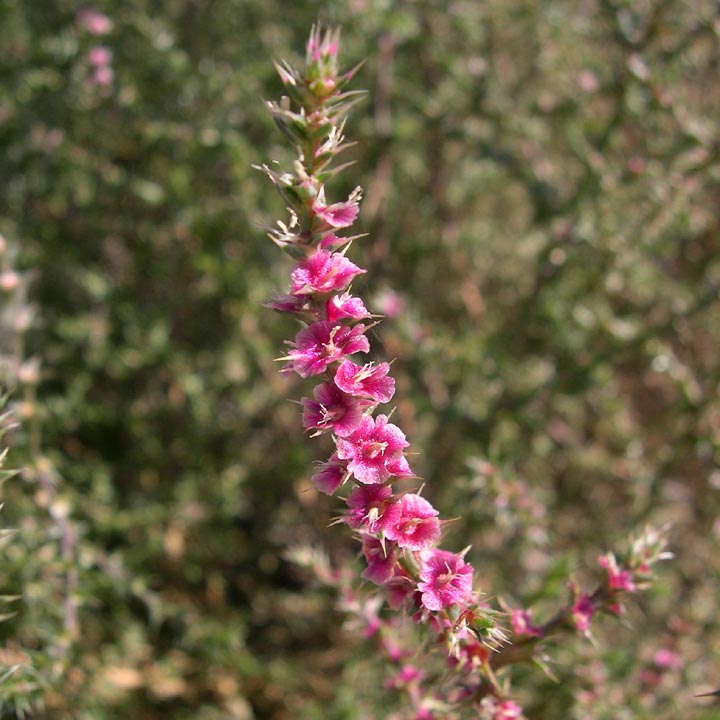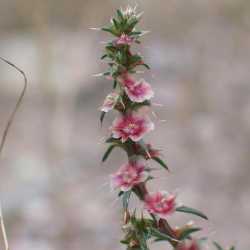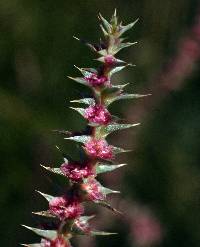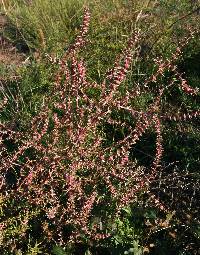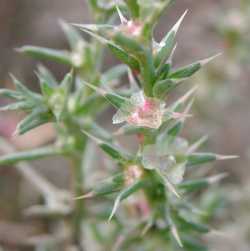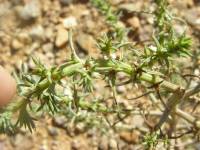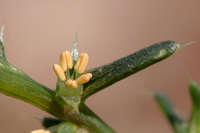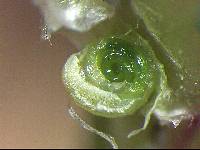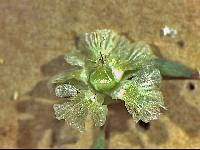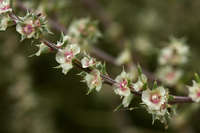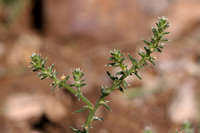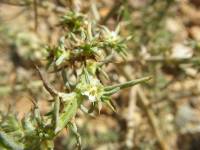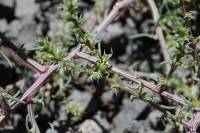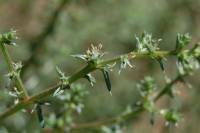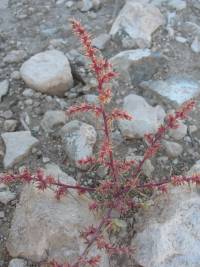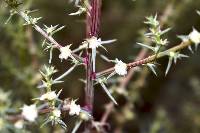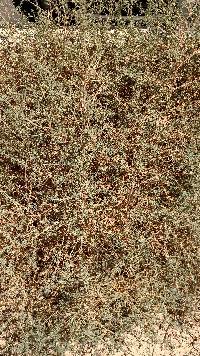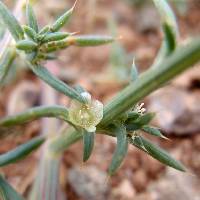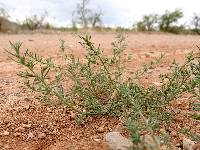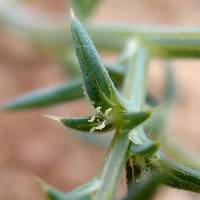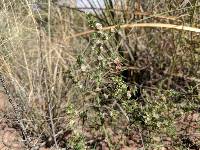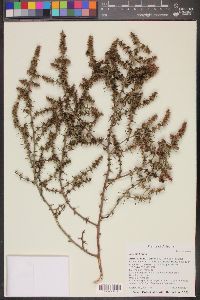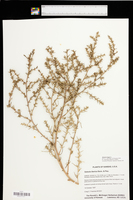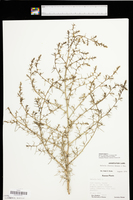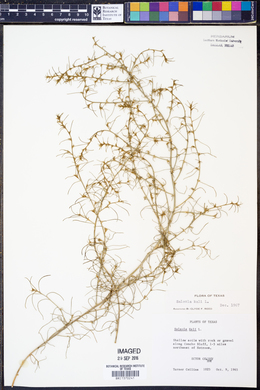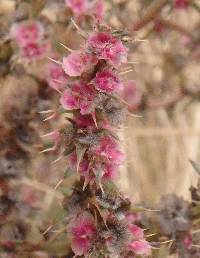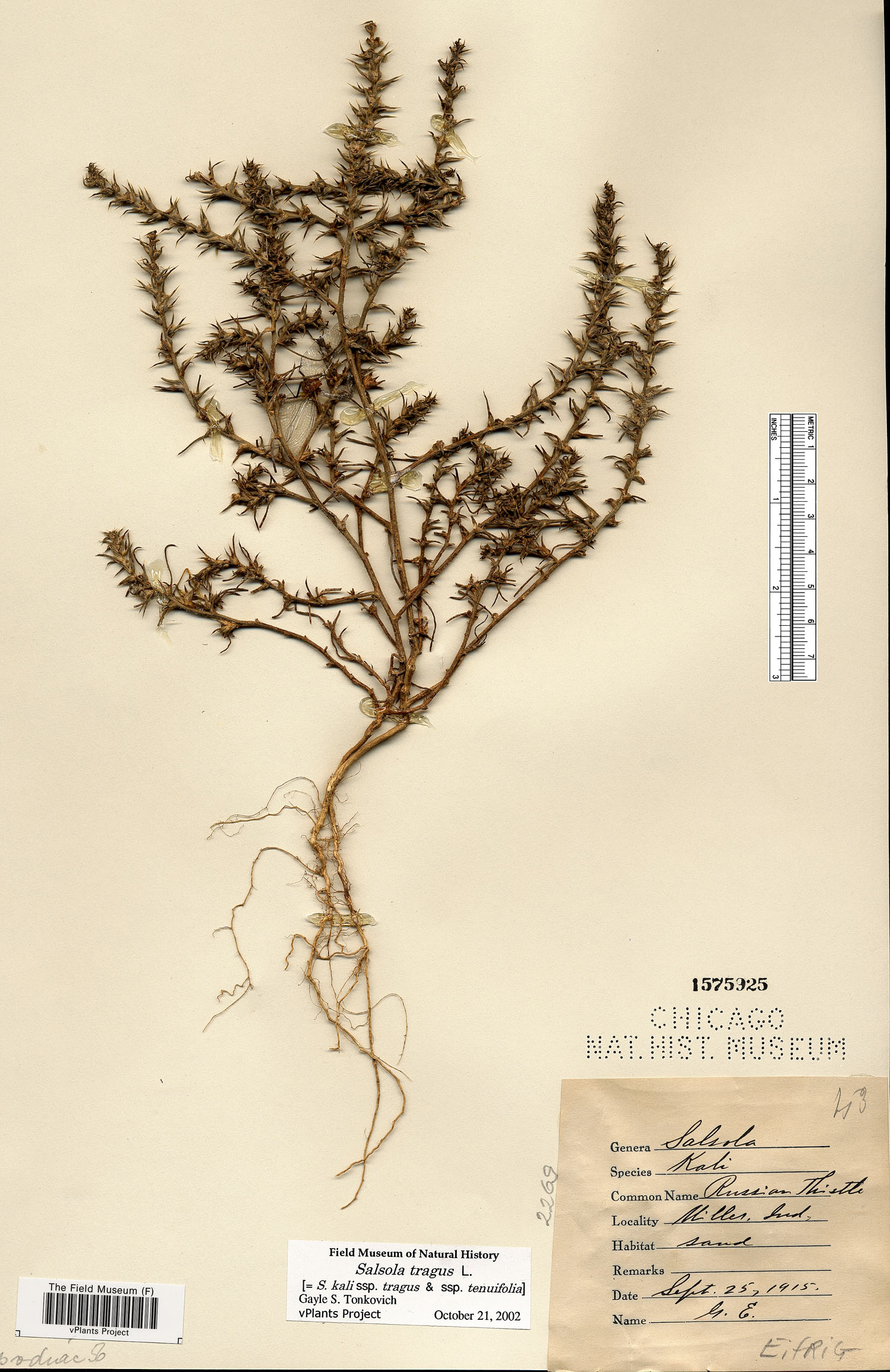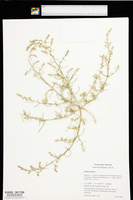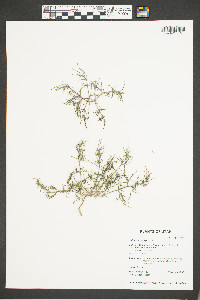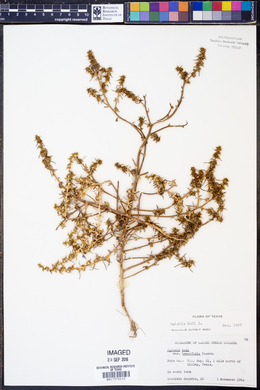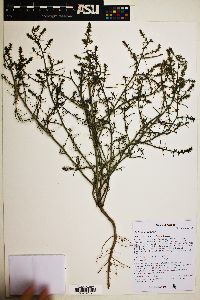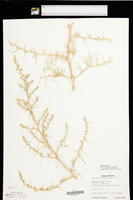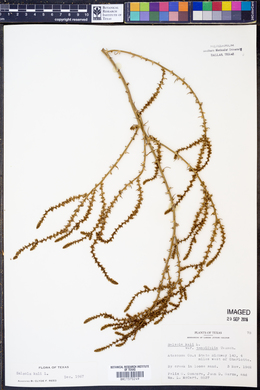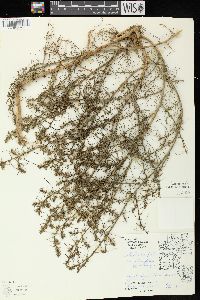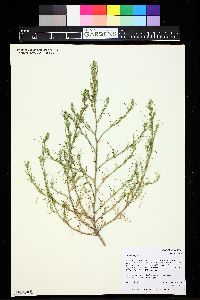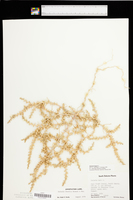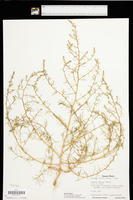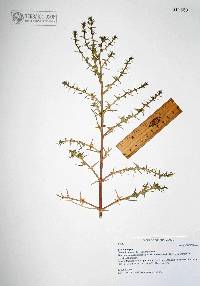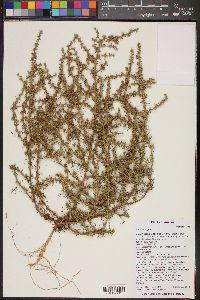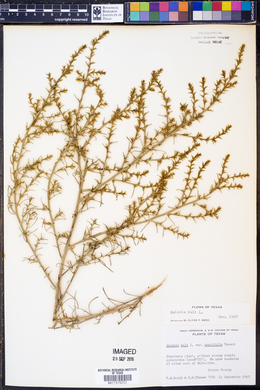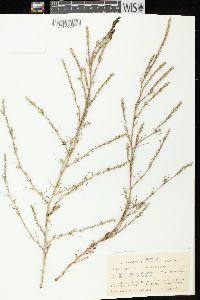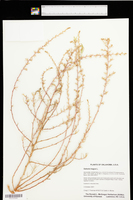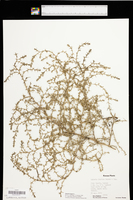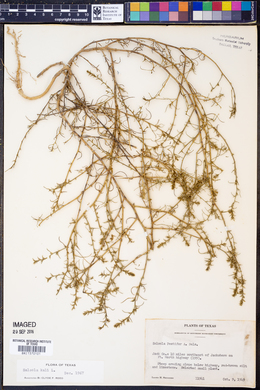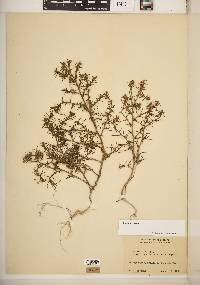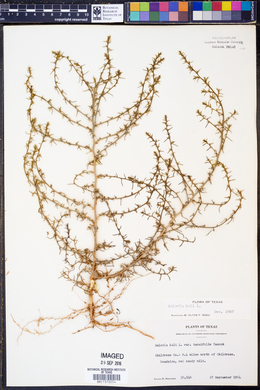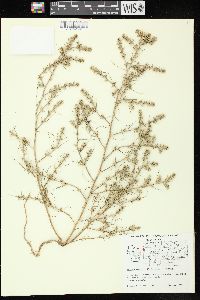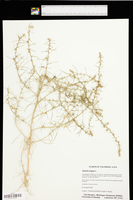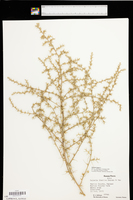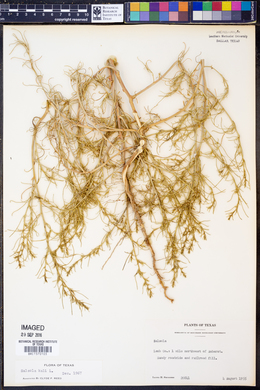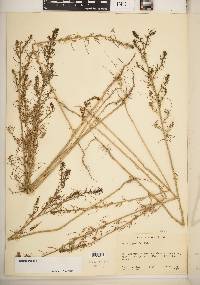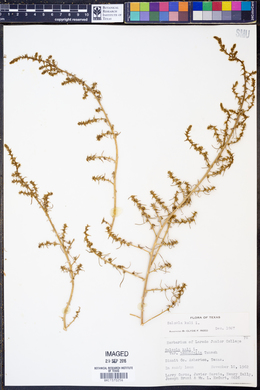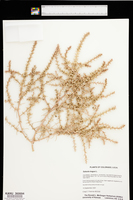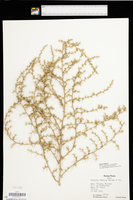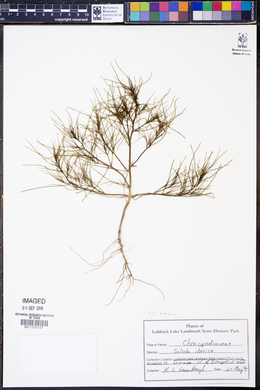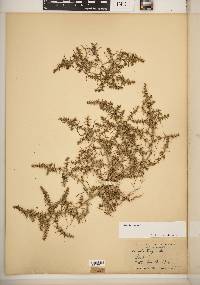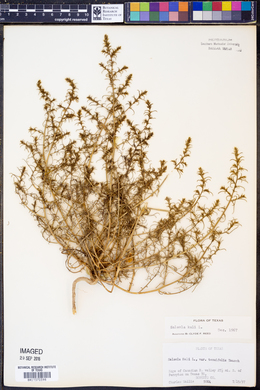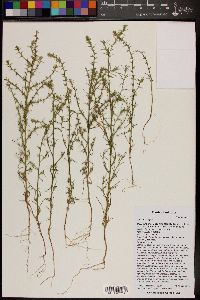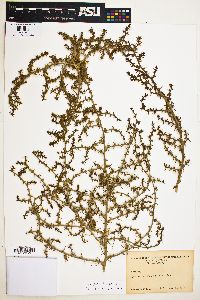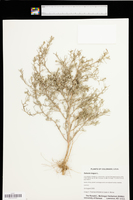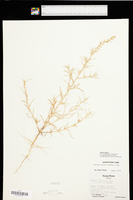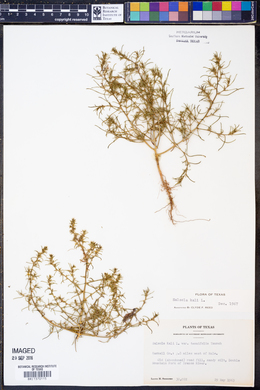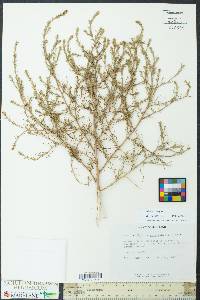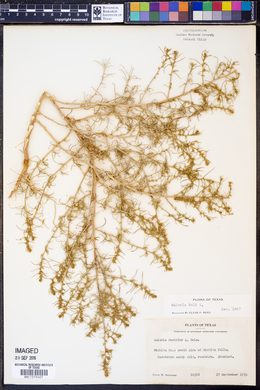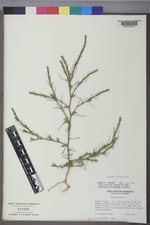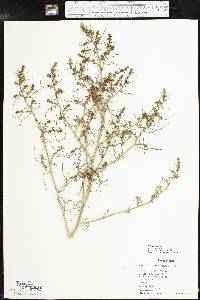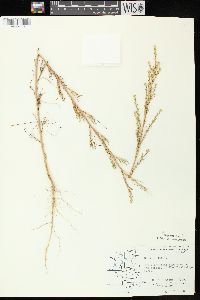Salsola tragus
|
|
|
|
Family: Amaranthaceae
Prickly Russian-Thistle
[Salsola australis R. Br., moreSalsola iberica (Sennen & Pau) Botsch. ex Czerepanov, Salsola kali subsp. tenuifolia Moq., Salsola kali subsp. tragus (L.) Celak., Salsola kali var. tenuifolia Tausch, Salsola pestifer A. Nels.] |
Herbs, (5-)10-100 cm, sparsely papillose to hispid or glabrous. Stems erect, rarely ascending, profusely branched from or near base (rarely simple in underdeveloped specimens); branches arcuate, proximal ones occasionally ± prostrate. Leaves alternate; blade filiform or narrowly linear, less than 1 mm wide in herbarium specimens, not fleshy, not swollen at base, apex subspinescent (spine less than 1.5 mm). Inflorescences interrupted at maturity (at least proximally), 1-flowered (rarely 2-3-flowered with lateral flowers mostly abortive); bracts alternate at maturity, not imbricate, reflexed, not distinctly swollen at base, ± abruptly narrowing into mucronulate-spinose apex. Flowers: bracteoles distinct or occasionally connate at base in proximal flowers; perianth segments with prominent, membranous wing at maturity (two inner wings usually much smaller than the other three), apex weak, obtuse to weakly acuminate or reflexed, glabrous; fruiting perianth ca. 4-10 mm diam. 2n = 36. Flowering summer-fall. Disturbed areas, roadsides, cultivated fields, coastal and riparian sands, semideserts, deserts, eroded slopes; 0-2500 m; introduced; Alta., B.C., Man., N.B., Nfld. & Labr., N.S., Ont., P.E.I., Que., Sask.; Ala., Ariz., Ark., Calif., Colo., Conn., Del., D.C., Ga., Idaho, Ill., Ind., Iowa, Kans., Ky., La., Maine, Md., Mass., Mich., Minn., Miss., Mo., Mont., Nebr., Nev., N.H., N.J., N.Mex., N.Y., N.C., N.Dak., Ohio, Okla., Oreg., Pa., R.I., S.C., S.Dak., Tenn., Tex., Utah, Vt., Va., Wash., W.Va., Wis., Wyo.; Mexico; Eurasia; naturalized Central America, South America, s Africa, Australia. Salsola tragus probably was introduced to South Dakota in 1870 or 1874 in flaxseed imported from Russia (J. C. Beatley 1973c; C. W. Crompton and I. J. Bassett 1985; S. L. Mosyakin 1996). Now this noxious weed occupies almost all of its potential range in North America. It seems, however, to be quite rare in the southeastern part of the United States. Salsola tragus has been known in North American and European botanical literature under numerous names (for detailed synonymy see S. L. Mosyakin 1996 and S. Rilke 1999). Judging from the photographs of the Linnaean specimen of S. tragus (LINN 315.3), which should be regarded as a lectotype, it is the correct name for the widespread, narrow-leaved, weedy representative of the S. kali aggregate (Á. Degen 1936-1938, vol. 2; N. N. Tzvelev 1993; S. L. Mosyakin 1996; S. Rilke 1999). In the present circumscription, Salsola tragus is an extremely polymorphic species consisting of several more or less distinct races (subspecies or segregate species). Several varieties may be recognized within S. tragus, many of them are just morphological variants of little or no taxonomic value. Studies using allozymes and DNA-based molecular markers in some North American and Eurasian representatives of Salsola tragus indicate that there are at least two cryptic genetically divergent populations (F. J. Ryan and D. R. Ayres 2000). More studies may clarify distribution, origin, and taxonomic status of these infraspecific taxa (or cryptic species). In spite of being a noxious weed, Salsola tragus is an additional forage source for livestock in arid rangelands. The mature plant may break off at the stem base to form a tumbleweed.
Annual herb, becoming a tumbleweed 10 cm - 1 m wide Stem: upright, much-branched from at or near base, often curved, becoming rigid. Leaves: alternate, stalkless, 1 - 6 cm long, reduced upwards (eventually giving way to the bracts), thread-like to narrowly linear with a small spine at the tip. Flowers: solitary or few in upper axils, subtended by two small bracts, greenish, small, with five distinct sepals and no petals. Bracts alternate, reflexed, egg- lance-shaped with a spiny tip. Stamens five. Stigmas two. Fruit: one-seeded (utricle), surrounded by the persistent, often winged sepals, 3 - 10 mm wide, subtended by two small bracts and one larger one. Bracts spine-tipped and much longer than the sepals. Wall (pericarp) adhered to the seed. Seed horizontal, black, spherical, thick. Similar species: No information at this time. Flowering: mid-July to early October Habitat and ecology: Introduced from Asia. Found in railroad ballast and in sandy soil. Grows along the beaches of Lake Michigan. Occurence in the Chicago region: non-native Etymology: Salsola comes from the Latin word salsa, meaning salty. Tragus comes from the Greek word tragos, meaning "hairy part of the ear" or goat. Author: The Morton Arboretum FNA 2003, Heil et al 2013 Duration: Annual Nativity: Non-Native Lifeform: Forb/Herb General: Introduced annual; up to 100 cm; many-branched stems which detach at the base after fruiting; often w/reddish, longitudinal striations; glabrous or somewhat hairy. Fresh young plants have succulent stems and leaves, which harden with age. Leaves: Alternate, sessile, thread-like, 1-5 cm, rigid with maturity; sharp-tipped. Flowers: Solitary flowers located in leaf axils; flowers perfect, 5-merous, without petals; sepals pink-white 2.5-3 mm. Fruits: Small; seeds shiny black, 1-2 mm wide. Ecology: Widespread on disturbed ground; 0-8,000 ft (0-2440 m) Distribution: Native to Eurasia and introduced to every continent in the world. Throughout the Americas and in every state in the US except AK. Notes: Native to Eurasia. This is the genus of the common tumbleweed. S. tragus is an annual, has many-branched stems, leaves which are mostly <1mm (in dried specimens) and become rigid and sharp-tipped at maturity, and small flowers in the axils. This plant is a very problematic invasive in North America. Livestock, mule deer, and elk all forage on it, and pronghorn eat summer growth. Seeds are eaten by 8 species of granivorous birds and small mammals. It is also used as cover by birds and small mammals. Host plant for Western Pygmy Blue butterfly. Ethnobotany: Extremely tasty as cooked spinach - eat whole plant up to 5 inches tall- double boil to remove bitterness and only eat young plants. Young plants also for sheep and horse feed. Navajos used it to treat influenza, small pox, and insect bites. Etymology: Salsola is from Latin salsus, for salty, while tragus is ancient word for goat. Synonyms: Salsola australis, S. iberica, S. kali subsp. ruthenica, S. kali subsp. tenuifolia, S. kali subsp. tragus, S. pestifer, S. ruthenica Editor: SBuckley 2010, FSCoburn 2014, AHazelton 2015 Glabrous or hispidulous, freely and diffusely branched, becoming rigid, forming a loose ball 2-10 dm that eventually breaks off at the ground and becomes a tumbleweed; lvs narrowly linear, 1-3 (the lower to 6) cm, reduced upwards and passing into the divergent, spinescent, ±setulose-serrulate, basally scarious-margined bracts; bracteoles 2.5-3.5 mm, also pungent; sep at anthesis soft, muticous, the midvein obscure; fruiting cal 3-10 mm wide, the lower fls often with the sep merely carinate, the others with the sep developing a prominently veined wing on the back; embryo closely coiled in several layers; 2n=36. Native to Eurasia, now widespread as a weed, abundant in the drier parts of w. N. Amer., less commonly in our range. (S. kali var. tenuifolia; S. iberica; S. pestifer; S. ruthenica) Gleason, Henry A. & Cronquist, Arthur J. 1991. Manual of vascular plants of northeastern United States and adjacent Canada. lxxv + 910 pp. ©The New York Botanical Garden. All rights reserved. Used by permission. From Flora of Indiana (1940) by Charles C. Deam In sandy soil in waste grounds and along beaches and roadsides. Introduced in America. …… Indiana Coefficient of Conservatism: C = null, non-native Wetland Indicator Status: FACU Diagnostic Traits: leaves alternate, terete, tipped by a spine (greater than 0.5 mm long); flowers sessile in axiles of fleshy bracts, arranged in a loose spike; calyx broadly winged in fruit. |
|
|
|

